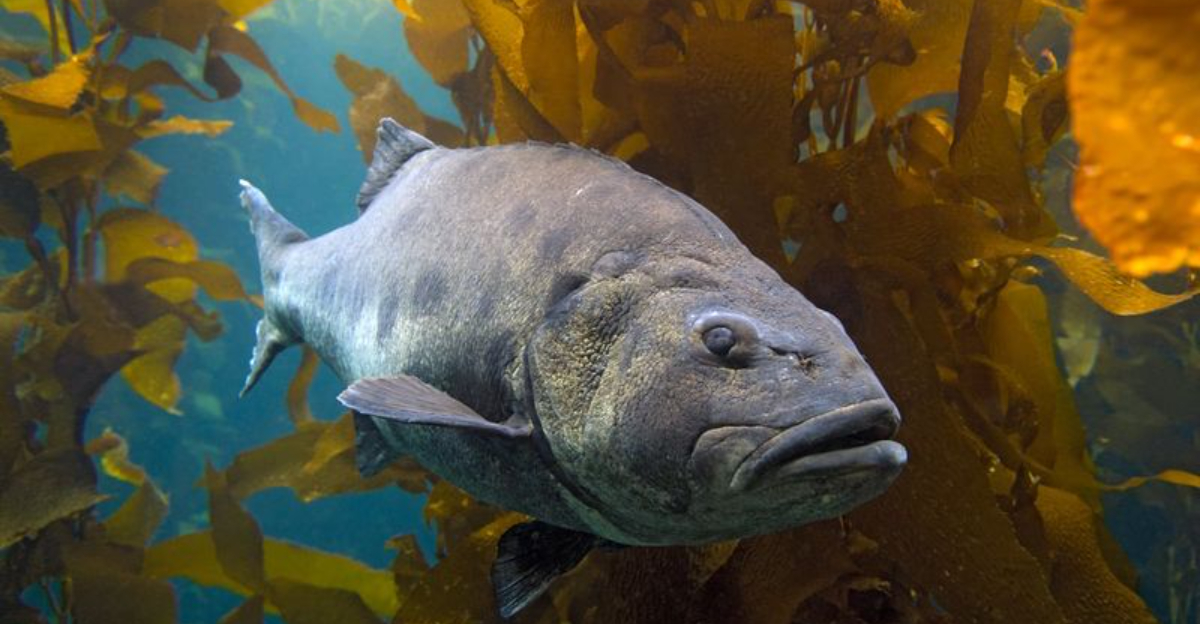Last summer on a fishing trip in Florida, I had a close encounter with a fish far bigger than I expected—it gave me a whole new respect for what’s out there.
Across the U.S., from coastal waters to quiet inland lakes, some fish grow to truly massive sizes. These aquatic giants may not always make headlines, but they’re out there—and they’re impressive.
Let’s take a look at some of the biggest fish that rule America’s waters.
1. Great White Shark: The Infamous Ocean Predator

Forget what you learned from Jaws—these misunderstood hunters aren’t the mindless eating machines Hollywood portrays. Growing up to 20 feet long and weighing over 4,000 pounds, great whites patrol coastal waters from California to New England.
Their powerful torpedo-shaped bodies can burst through water at 35 mph when hunting seals or sea lions. Despite their fearsome reputation, attacks on humans remain incredibly rare.
Scientists now understand these magnificent creatures are curious, intelligent, and essential to ocean health. Without these apex predators keeping marine populations in check, entire ecosystems would collapse.
2. White Sturgeon: Living Dinosaur of the Pacific Northwest

Swimming through the rivers of time since the dinosaurs roamed, white sturgeon haven’t changed much in 200 million years. These prehistoric giants can grow over 20 feet long and live more than a century, with some specimens weighing a staggering 1,500 pounds.
Armored with bony plates instead of scales, they vacuum up food from river bottoms using their tube-like mouths. The Columbia and Sacramento Rivers host the largest populations in America.
Sadly, dam construction and overfishing have threatened these ancient fish. Conservation efforts now protect these gentle giants who were once nearly fished to extinction for their eggs (caviar).
3. Lake Sturgeon: Freshwater Giants of the Great Lakes
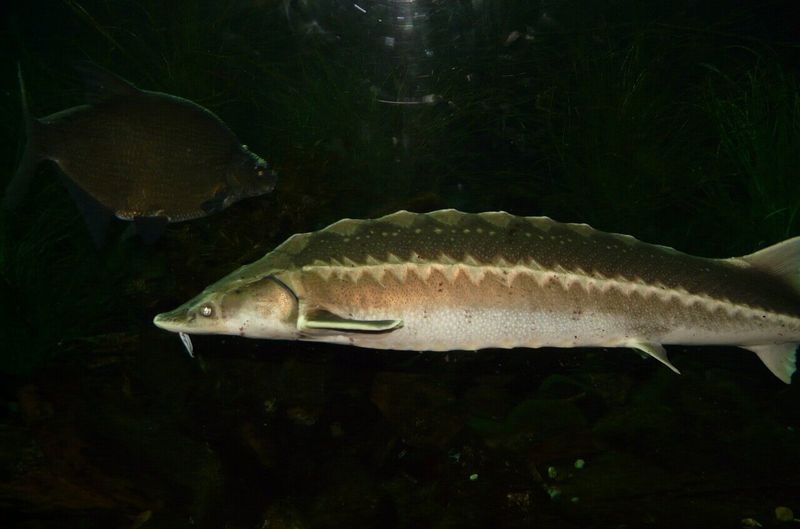
These freshwater leviathans are cousins of the white sturgeon and have been cruising the Great Lakes region since before Europeans arrived on American shores. With their shark-like tails and armored bodies, lake sturgeon look like something from another era—because they are!
Males typically reach 6 feet, while females can stretch to an impressive 9 feet and tip scales at 300 pounds. Their vacuum-like mouths suck up small creatures from lake bottoms as they patrol the depths.
Once nearly wiped out by commercial fishing and pollution, lake sturgeon are making a comeback thanks to dedicated conservation programs throughout the Midwest.
4. Bluefin Tuna: Speed Demons of the Atlantic
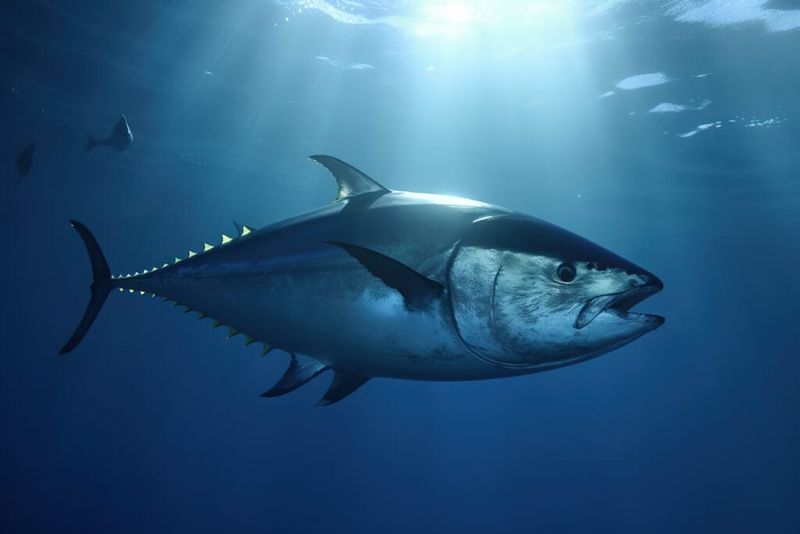
With their rocket-like shape and speed, Atlantic bluefin tuna are the Formula 1 cars of the ocean. These muscular marvels can reach 10 feet long and weigh over 1,000 pounds while slicing through water at highway speeds of 40+ mph.
Their warm-blooded metabolism—unusual for fish—allows them to hunt in cold Atlantic waters where other predators can’t function. Commercial fishermen prize bluefin for their rich, red meat that commands astronomical prices in sushi markets.
Unfortunately, their delicious taste has led to severe overfishing. Conservation measures now aim to protect these magnificent swimmers that migrate thousands of miles between feeding and spawning grounds.
5. Ocean Sunfish: The Floating Pancake
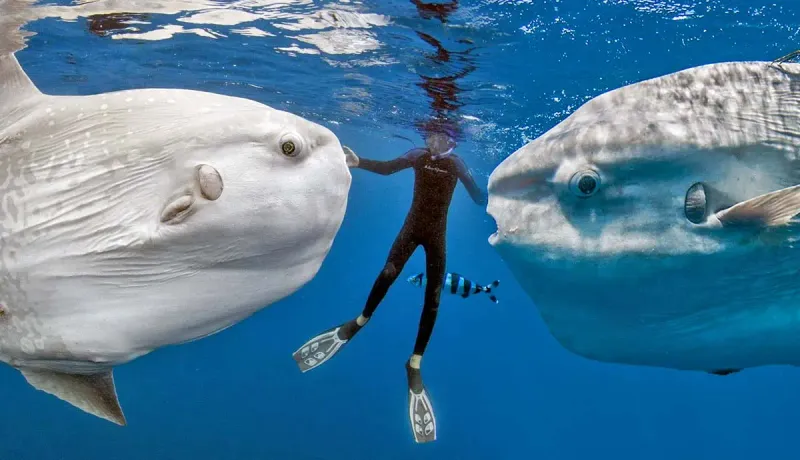
Mother Nature clearly had a sense of humor when designing the ocean sunfish (Mola mola). Imagine a swimming head without a proper tail—just a flat, rounded body that can reach 10 feet across and weigh up to 5,000 pounds!
Despite their comical appearance, these gentle giants are master jellyfish hunters along both U.S. coasts. Often spotted lazily basking at the surface (hence their name), sunfish conserve energy by soaking up warmth before diving hundreds of feet deep.
Their weird bodies generate more questions than answers for marine biologists. Female sunfish hold the record for most eggs produced by any vertebrate—up to 300 million at once!
6. Giant Sea Bass: California’s Underwater Bulldozers
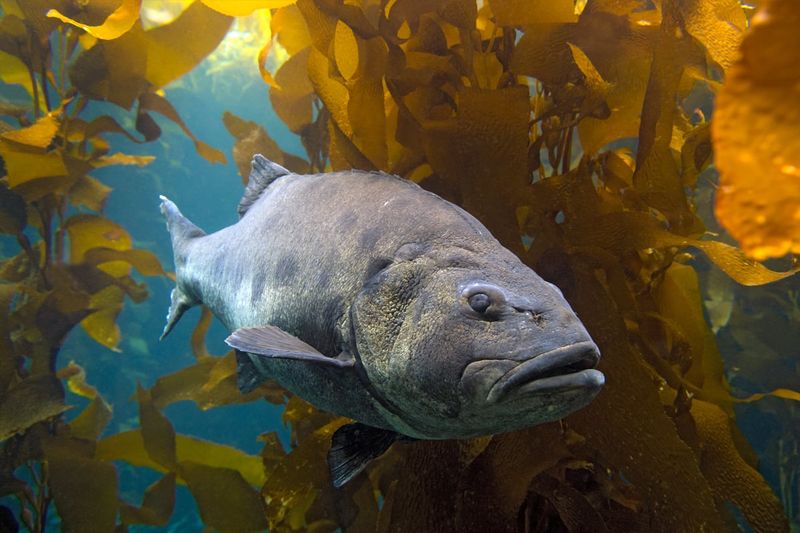
Looking like they swallowed a Volkswagen Beetle, giant sea bass patrol kelp forests and rocky reefs along the California coast. These behemoths can stretch over 7 feet long and weigh up to 700 pounds—with mouths large enough to swallow a basketball!
Surprisingly gentle despite their imposing size, they move with the deliberate grace of underwater bulldozers. Their mottled black and gray coloration provides ideal camouflage as they ambush prey or hover motionless among kelp strands.
Once fished to near extinction, strict protection has helped these magnificent creatures begin a slow recovery. Divers now celebrate spotting these gentle giants that can live over 75 years.
7. Lingcod: The Pacific’s Toothy Ambush Predator
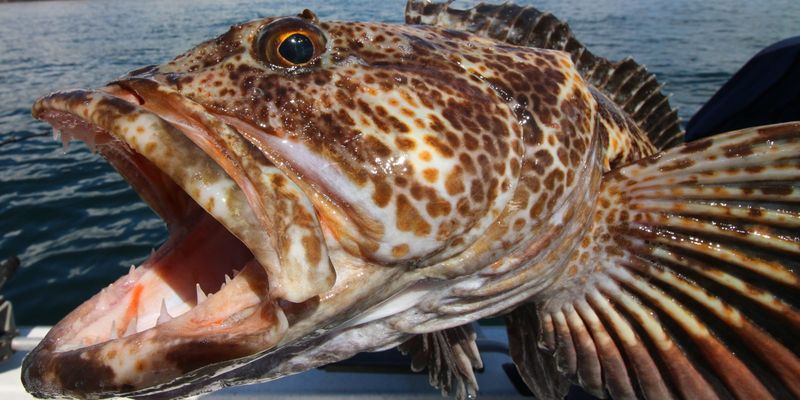
With a face only a mother could love, lingcod aren’t actually cod at all but belong to the greenling family. These Pacific coast monsters sport a nightmare-inducing mouth filled with 18 needle-sharp teeth, some nearly an inch long!
Trophy specimens reach 5 feet and tip scales at 80 pounds, though most are smaller. Their mottled coloration grants effective camouflage on rocky bottoms where they wait motionless before lunging at prey with lightning speed.
Strangest of all? Many lingcod have bright blue or green meat—perfectly safe to eat despite the alien coloration. Pacific Northwest anglers prize these aggressive fighters that taste delicious despite their frightening appearance.
8. Atlantic Goliath Grouper: Florida’s Underwater Giants
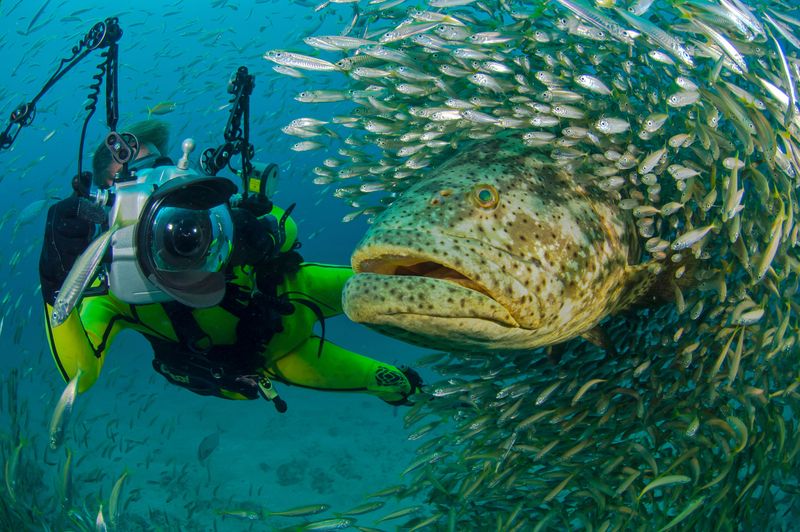
When something the size of a small car appears from beneath a Florida reef, you’ve probably just met a goliath grouper. These massive reef dwellers can reach 8 feet long and weigh over 800 pounds—making them the largest reef fish in the Atlantic!
Masters of ambush hunting, they simply open their bucket-sized mouths to create suction that inhales unsuspecting prey whole. Their booming underwater “bark” can be so powerful it knocks divers backward with the sound wave alone.
After nearly being wiped out by spearfishing in the 1980s, strict protection has helped these gentle giants recover. Now they’re beloved attractions at shipwrecks and artificial reefs throughout Florida and the Gulf Coast.
9. Greenland Shark: The Arctic’s Slow-Motion Giant
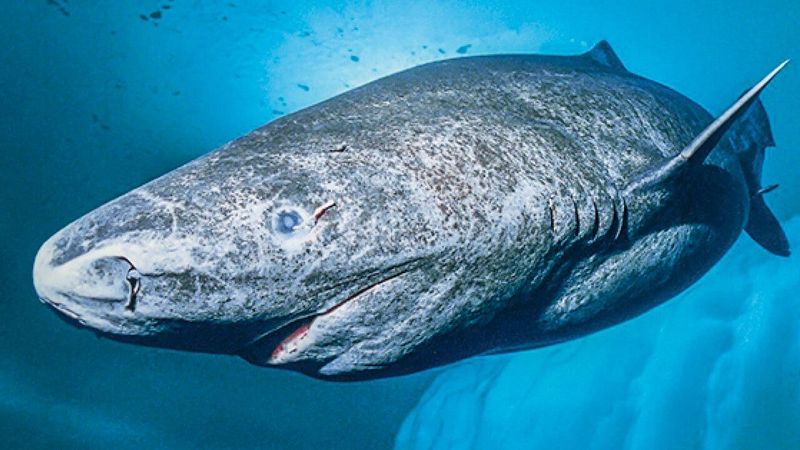
Gliding through frigid Arctic waters like ghosts, Greenland sharks are living time capsules that can survive for centuries. Scientists discovered some individuals are over 400 years old—possibly the longest-lived vertebrates on Earth!
Growing to 24 feet and weighing up to 3,000 pounds, these deep-water predators move in slow motion thanks to their cold-water metabolism. They cruise at a leisurely 0.7 mph—slower than you can walk—but this doesn’t stop them from catching seals and other prey.
Though rarely seen by humans, their range extends into deeper waters off New England and Alaska. Their flesh contains toxins that cause “shark intoxication” if eaten fresh—yet Icelanders ferment it for months as a delicacy.
10. Big Skate: The Pacific’s Giant Flying Carpet
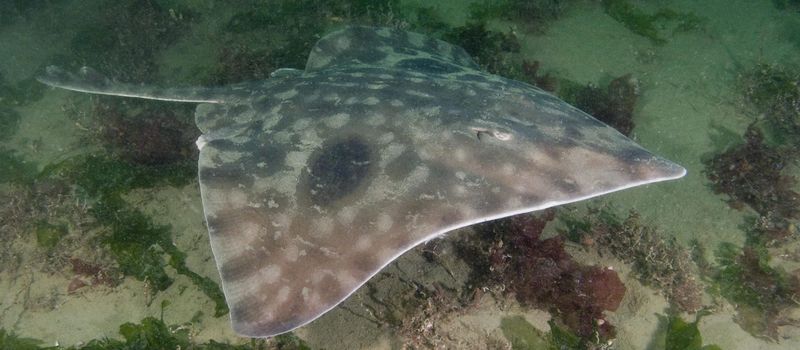
Gliding like underwater flying carpets, big skates drift gracefully along the Pacific seafloor, from the icy waters of Alaska to sunny California coasts. These diamond-shaped relatives of sharks can reach 8 feet across and weigh 200 pounds—making them the largest skates in North American waters.
Unlike their stingray cousins, skates lack venomous spines, instead relying on thorny projections along their backs and tails for protection. They use electrosensory organs to detect prey hiding beneath sand, then pounce with surprising speed.
Female big skates lay the largest egg cases in the world—leathery “mermaid’s purses” nearly a foot long that sometimes wash ashore. Inside each case, tiny skates develop for months before emerging as miniature versions of their parents.
11. Blue Catfish: River Monsters of the Mississippi
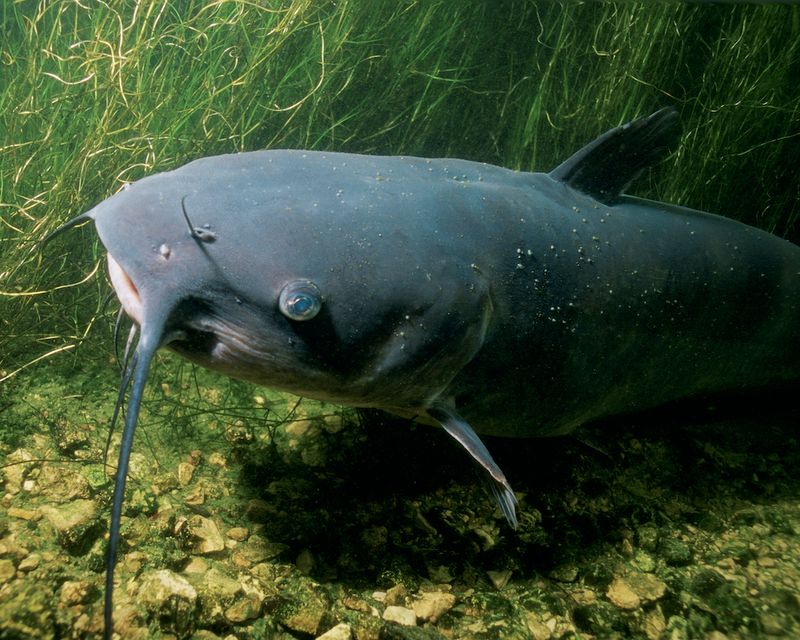
Lurking in the murky depths of America’s great rivers swim whiskered giants that would make most anglers’ knees shake. Blue catfish—the largest catfish species in North America—can reach truly monstrous proportions exceeding 5 feet and 150 pounds!
Armed with sensitive barbels (“whiskers”) that detect food in zero visibility, these opportunistic predators devour anything they can fit in their cavernous mouths. The Mississippi, Missouri, and Ohio River systems host the biggest specimens, though they’ve been introduced to many eastern watersheds.
Record-hunters often target blue cats at night when these behemoths leave deep holes to feed. The current world record stands at a jaw-dropping 143 pounds—heavier than many human anglers!
12. American Paddlefish: Prehistoric Filter-Feeders
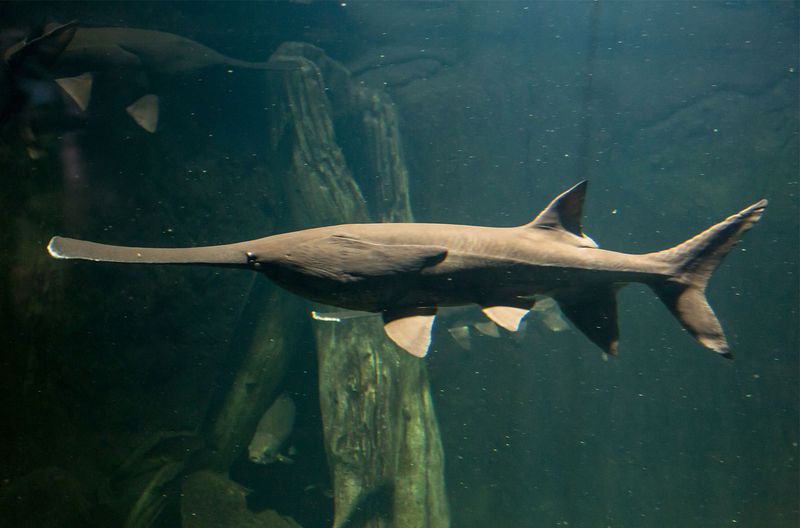
A creature so bizarre swims through America’s heartland rivers, it feels more like science fiction than reality. American paddlefish have enormous paddle-shaped snouts (rostrum) that can make up one-third of their total body length—reaching 7 feet long and 200 pounds!
These ancient fish have roamed North American waters for 65 million years, using electrosensory organs in their paddles to detect tiny zooplankton. Unlike most fish, they don’t chase prey but swim with mouths wide open, filtering food through specialized gill rakers.
Found primarily in the Mississippi River basin, paddlefish face threats from dam construction that blocks spawning migrations. Their eggs are prized as “American caviar,” making them targets for poachers despite protected status in many states.
13. The Surprise Giant: Alligator Gar
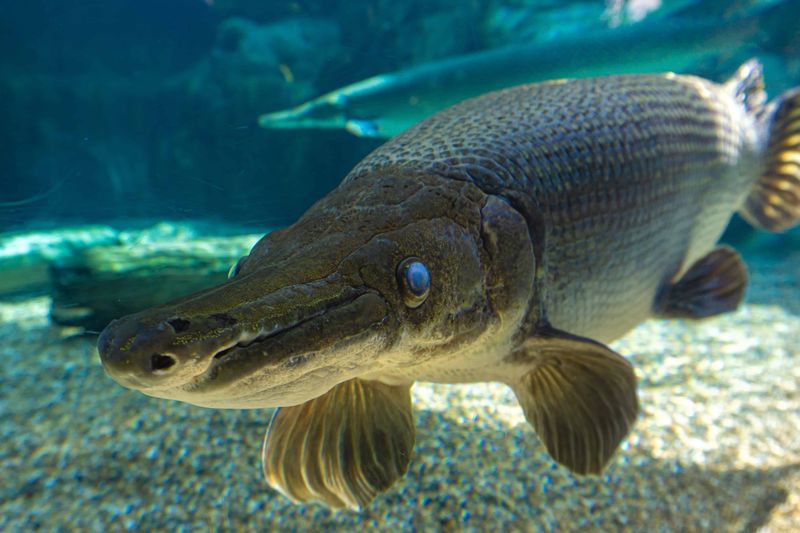
With a face straight from the dinosaur era and armor-like scales that can deflect arrows, alligator gar are the stuff of fishing nightmares. These prehistoric monsters can exceed 10 feet and weigh over 300 pounds in southern waters from Texas to Florida!
Their double row of alligator-like teeth inspired their name, though they’re completely harmless to humans despite terrifying appearances. Capable of breathing air through a primitive lung, they survive in oxygen-poor waters where other fish perish.
Once considered “trash fish” and targeted for elimination, scientists now recognize these living fossils as important apex predators. Some specimens live 50+ years, with females typically growing much larger than males.
